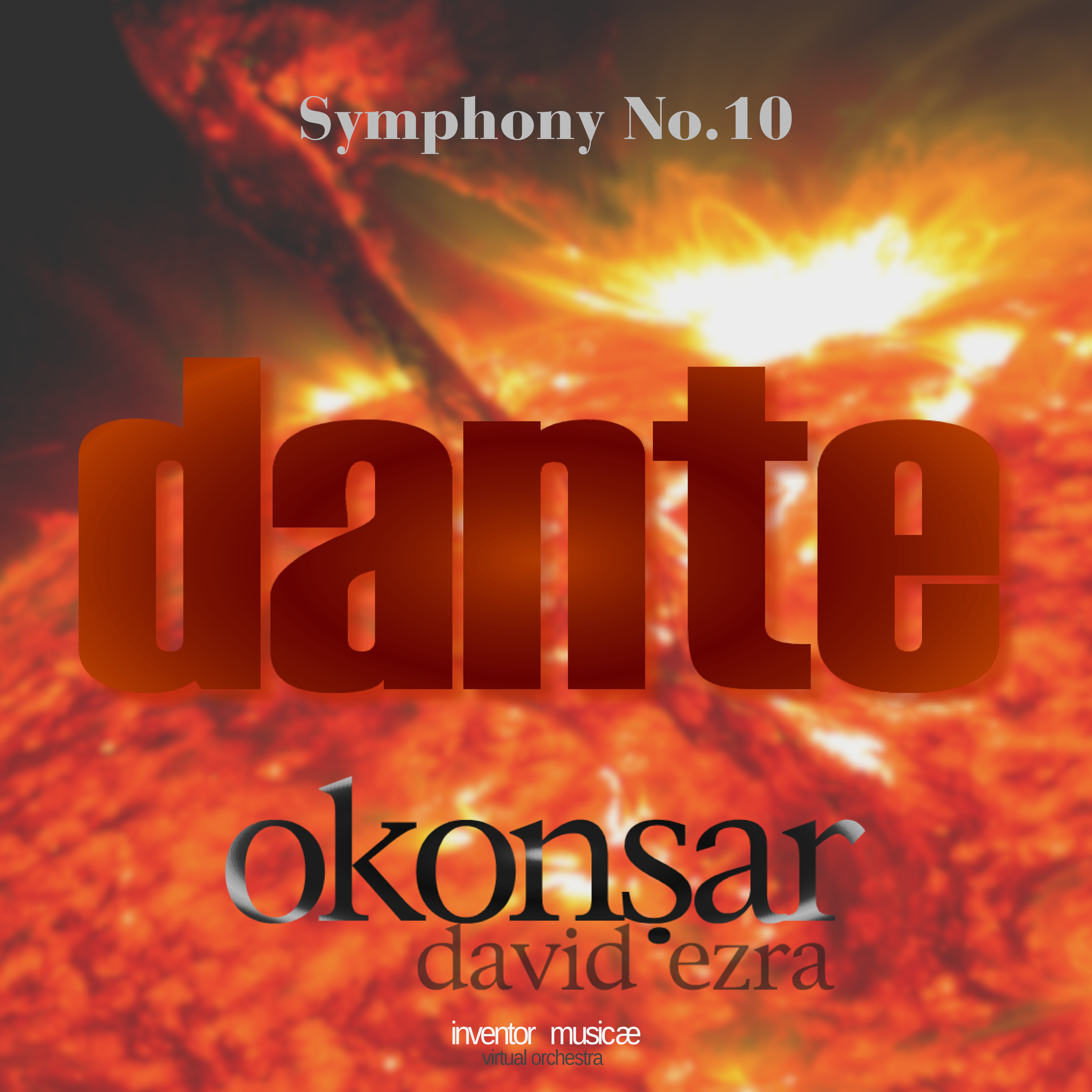
Downloads only. Physical CD not available.
|
Dante Alighieri's Divine Comedy is considered one of the greatest works of world literature. Its complexity, beauty, and profound exploration of theology and philosophy have solidified its lasting impact on Western culture. Dante created a vivid depiction of the afterlife in this monumental work that continues to captivate readers and scholars alike. The epic series of cantics which makes the Commedia is a journey through Hell, Purgatory, and Heaven, guided by the poet Virgil and his beloved Beatrice. Through vivid imagery and allegorical characters, Dante weaves a narrative that explores themes of sin, redemption, and the human experience. The work inspired many composers to create musical adaptations based on its themes and characters. Among them are Franz Liszt, Richard Wagner, and Igor Stravinsky. The Dante-Symphony (No. 10) by David Ezra Okonşar is another example of how Dante's Divine Comedy continues influencing artists across different mediums. These musical interpretations bring a new dimension to Dante's timeless masterpiece, showcasing its enduring relevance and impact on creative expression. The symphony takes the audience on a journey through the depths of hell, purgatory, and heaven, using a unique blend of instrumentation and orchestral colors to capture the emotional intensity and spiritual journey of Dante's work. By blending classical music with modern instruments, the Dante-Symphony by David Ezra Okonşar offers a fresh perspective on the iconic narrative, captivating audiences with its innovative approach to storytelling through music. The composition has three main movements (hell, purgatory, and paradise) and seven or nine sub-movements, following the subdivisions ("circles") of the Divine Comedy's hell (9), purgatory (7), and heaven (9) sections. Additionally, the composition incorporates a wide range of instruments, both traditional and electronic, as well as vocal styles to enhance the narrative and emotional impact. The pitch-class organization of the symphony is as follows: 4 Main ("key") pitches are set for each movement. These are heard in isolation at the beginning and end of each movement. The "key" pitches are I. Cantica (inferno): C, C#, F#, B; II: Cantica: (purgatorio): D, F, Bf, E and III: Cantica (paradise): Ef, G, Af, A. For each movement, 2 or 3 of these are repeated in the pitch universe, thus reducing the number of usable pitches out of 12. Reused pitches are I. Cantica: Inferno {C, F#}; II: Cantica: Purgatorio {F, Bf, E} and III: Cantica: Paradiso {Ef, G, A} . Cantica: Inferno {C, F #}; II: Cantica: Purgatorio {F, Bf, E} and III: Cantica: Paradiso {Ef, G, A}. Reusing pitches in this way creates a sense of unity and cohesion within the movement, and the 'absent' pitches give the section its own distinctive sound color, engaging the audience in a unique musical experience. Three "leitmotifs" are present throughout the entire symphony: the "Dante-Theme," "Virgil-Theme," and "Beatrice-Theme." These leitmotifs are woven into the fabric of the symphony, representing the characters and themes from Dante's Divine Comedy. The repetition of certain pitches and motifs helps to guide the listener through the complex structure of the piece, creating a cohesive and immersive listening experience. The Dante Symphony (No. 10) by Okonşar is a masterful example of programmatic music. Drawing inspiration from Dante Alighieri's epic poem, Okonşar's use of leitmotifs and unique orchestration techniques creates a rich tapestry of sound that transports the listener into the world of the Divine Comedy.
-------------------------------------------------- FR La Divine Comédie de Dante Alighieri est considérée comme l'une des plus grandes œuvres de la littérature mondiale. Sa complexité, sa beauté et son exploration profonde de la théologie et de la philosophie ont solidifié son impact durable sur la culture occidentale. Dante a créé une représentation vivante de l'au-delà dans cette œuvre monumentale qui continue de captiver les lecteurs et les érudits. La série épique de cantiques qui compose la Commedia est un voyage à travers l'enfer, le purgatoire et le paradis, guidé par le poète Virgile et sa bien-aimée Béatrice. À travers des images vives et des personnages allégoriques, Dante tisse un récit qui explore les thèmes du péché, de la rédemption et de l'expérience humaine. L'œuvre a inspiré de nombreux compositeurs à créer des adaptations musicales basées sur ses thèmes et ses personnages. Parmi eux figurent Franz Liszt, Richard Wagner et Igor Stravinsky. La Dante-Symphonie (n° 10) de David Ezra Okonşar est un autre exemple de la manière dont la Divine Comédie de Dante continue d'influencer les artistes à travers différents médiums. Ces interprétations musicales apportent une nouvelle dimension au chef-d'œuvre intemporel de Dante, mettant en valeur sa pertinence durable et son impact sur l'expression créative. La symphonie emmène le public dans un voyage à travers les profondeurs de l'enfer, du purgatoire et du paradis, en utilisant un mélange unique d'instrumentation et de couleurs orchestrales pour capturer l'intensité émotionnelle et le voyage spirituel de l'œuvre de Dante. En mélangeant la musique classique avec des instruments modernes, la Dante-Symphonie de David Ezra Okonşar offre une nouvelle perspective sur le récit emblématique, captivant le public avec son approche innovante de la narration à travers la musique. La composition comporte trois mouvements principaux (enfer, purgatoire et paradis) et sept ou neuf sous-mouvements, suivant les subdivisions (« cercles ») des sections de l'enfer (9), du purgatoire (7) et du paradis (9) de la Divine Comédie. De plus, la composition intègre une large gamme d'instruments, à la fois traditionnels et électroniques, ainsi que des styles vocaux pour renforcer l'impact narratif et émotionnel. L'organisation des notes de la symphonie est la suivante : 4 notes principales (« clés ») sont définies pour chaque mouvement. Elles sont entendues de manière isolée au début et à la fin de chaque mouvement. Les notes « clés » sont I. Cantica (enfer) : do, do#, fa#, si ; II : Cantica (purgatorio) : ré, fa, sif, mi et III : Cantica (paradis) : mi fa, sol, la, la. Pour chaque mouvement, 2 ou 3 d'entre elles sont répétées dans l'univers des notes, réduisant ainsi le nombre de notes utilisables sur 12. Les notes réutilisées sont I. Cantica : Inferno {do, fa#} ; II : Cantica : Purgatorio {fa, sif, mi} et III : Cantica : Paradiso {mi fa, sol, la} . Cantica : Inferno {do, fa #} ; II : Cantica : Purgatorio {F, Bf, E} et III : Cantica : Paradiso {Ef, G, A}. La réutilisation des hauteurs de cette manière crée un sentiment d'unité et de cohésion au sein du mouvement, et les hauteurs « absentes » donnent à la section sa propre couleur sonore distinctive, engageant le public dans une expérience musicale unique. Trois « leitmotivs » sont présents tout au long de la symphonie : le « thème de Dante », le « thème de Virgile » et le « thème de Béatrice ». Ces leitmotivs sont tissés dans la trame de la symphonie, représentant les personnages et les thèmes de la Divine Comédie de Dante. La répétition de certaines hauteurs et de certains motifs aide à guider l'auditeur à travers la structure complexe de la pièce, créant une expérience d'écoute cohérente et immersive. La Symphonie Dante (n° 10) d'Okonşar est un exemple magistral de musique programmatique. S'inspirant du poème épique de Dante Alighieri, l'utilisation de leitmotivs et de techniques d'orchestration uniques par Okonşar crée une riche tapisserie sonore qui transporte l'auditeur dans le monde de la Divine Comédie. -------------------------------------------------- TR Dante Alighieri'nin İlahi Komedya'sı dünya edebiyatının en büyük eserlerinden biri olarak kabul edilir. Karmaşıklığı, güzelliği ve teoloji ve felsefenin derinlemesine incelenmesi, Batı kültüründeki kalıcı etkisini sağlamlaştırmıştır. Dante, okuyucuları ve akademisyenleri büyülemeye devam eden bu anıtsal eserde, öbür dünyanın canlı bir tasvirini yaratmıştır. Commedia'yı oluşturan destansı ilahiler dizisi, şair Virgil ve sevgili Beatrice'in rehberliğinde Cehennem, Araf ve Cennet'te bir yolculuktur. Dante, canlı imgeler ve alegorik karakterler aracılığıyla günah, kurtuluş ve insan deneyimi temalarını inceleyen bir anlatı örer. Eser, birçok besteciye temalarına ve karakterlerine dayalı müzikal uyarlamalar yaratmaları için ilham vermiştir. Bunlar arasında Franz Liszt, Richard Wagner ve Igor Stravinsky bulunmaktadır. David Ezra Okonşar'ın Dante Senfonisi (No. 10), Dante'nin İlahi Komedya'sının farklı ortamlarda sanatçıları nasıl etkilemeye devam ettiğinin bir başka örneğidir. Bu müzikal yorumlar, Dante'nin zamansız şaheserine yeni bir boyut kazandırarak, onun kalıcı alaka düzeyini ve yaratıcı ifade üzerindeki etkisini sergiliyor. Senfoni, Dante'nin eserinin duygusal yoğunluğunu ve manevi yolculuğunu yakalamak için benzersiz bir enstrümantasyon ve orkestra renkleri karışımı kullanarak dinleyicileri cehennem, araf ve cennetin derinliklerinde bir yolculuğa çıkarıyor. David Ezra Okonşar'ın Dante Senfonisi, klasik müziği modern enstrümanlarla harmanlayarak, ikonik anlatıya yeni bir bakış açısı sunuyor ve müzik aracılığıyla hikaye anlatımına yönelik yenilikçi yaklaşımıyla dinleyicileri büyülüyor. Kompozisyonun üç ana bölümü (cehennem, araf ve cennet) ve İlahi Komedya'nın cehennem (9), araf (7) ve cennet (9) bölümlerinin alt bölümlerini ("çemberler") izleyen yedi veya dokuz alt bölümü var. Ek olarak, kompozisyon, anlatıyı ve duygusal etkiyi artırmak için hem geleneksel hem de elektronik olmak üzere çok çeşitli enstrümanların yanı sıra vokal stilleri de içeriyor. Senfoninin perde-sınıfı (PC-Class) organizasyonu şu şekildedir: Her bölüm için 4 Ana ("anahtar") perde ayarlanır. Bunlar her bölümün başında ve sonunda izole olarak duyulur. "Anahtar" perdeler şunlardır: I. Cantica (inferno): C, C#, F#, B; II: Cantica: (purgatorio): D, F, Bf, E ve III: Cantica (paradise): Ef, G, Af, A. Her bölüm için, perde evreninde (pitch-universe) bunlardan 2 veya 3'ü tekrarlanır, böylece 12'den kullanılabilir perdelerin sayısı azalır. Yeniden kullanılan perdeler şunlardır: I. Cantica: Inferno {C, F#}; II: Cantica: Purgatorio {F, Bf, E} ve III: Cantica: Paradiso {Ef, G, A}. Cantica: Inferno {C, F #}; II: Cantica: Purgatorio {F, Bf, E} ve III: Cantica: Paradiso {Ef, G, A}. Perdelerin bu şekilde yeniden kullanılması, bölüm içinde bir birlik ve bütünlük duygusu yaratır ve varolmayan perdeler bölüme kendine özgü ses rengini vererek dinleyicileri benzersiz bir müzik deneyimine dahil eder. Tüm senfoni boyunca üç "leitmotif" mevcuttur: "Dante Teması", "Virgilius Teması" ve "Beatrice Teması." Bu leitmotifler senfoninin dokusuna işlenmiştir ve Dante'nin İlahi Komedya'sındaki karakterleri ve temaları temsil eder. Belirli perdelerin ve motiflerin tekrarı, dinleyiciyi parçanın karmaşık yapısı boyunca yönlendirmeye yardımcı olarak bütünleşik ve sürükleyici bir dinleme deneyimi yaratır. Okonşar'ın Dante Senfonisi (No. 10) programatik müziğin ustaca bir örneğidir. Dante Alighieri'nin destansı şiirinden ilham alan Okonşar, kullandığı leitmotifler ve özgün orkestrasyon teknikleriyle dinleyiciyi İlahi Komedya dünyasına taşıyan zengin bir ses dokusu yaratıyor. |
||||||||||||||||||||||||
| |
||||||||||||||||||||||||
|
||||||||||||||||||||||||





